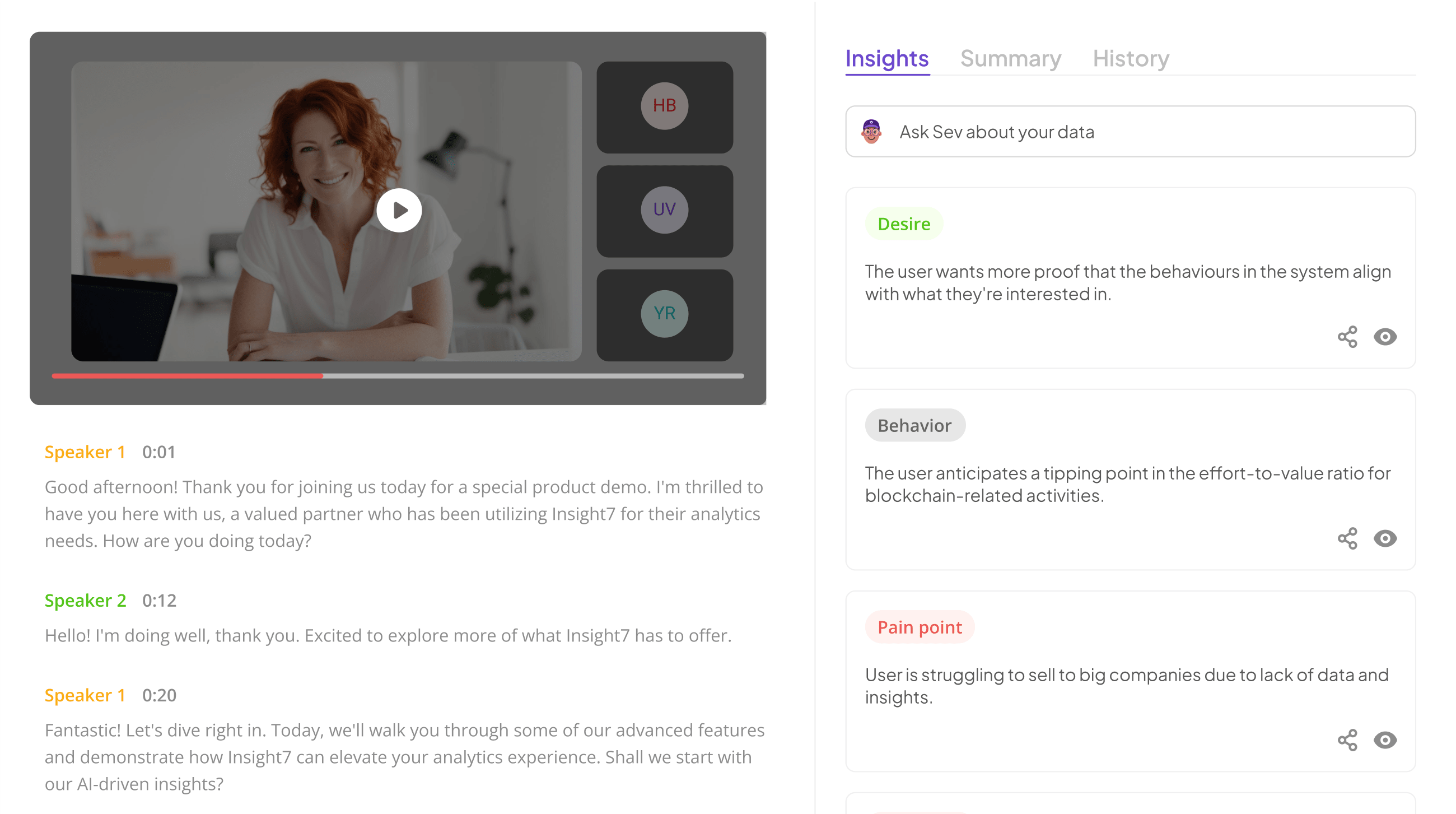Customer Review Analysis: How-to & Top Tools
-
Bella Williams
- 10 min read
Customer feedback serves as a goldmine of information for businesses seeking to refine their strategies. As organizations navigate this landscape, understanding how to utilize review insights tools becomes essential. These tools facilitate the extraction of meaningful data from customer reviews, enabling businesses to decipher trends and pain points effectively.
In this section, we will explore the significance of review insights tools in customer review analysis. By uncovering actionable insights, businesses can enhance customer experiences, drive growth, and ultimately foster a loyal customer base. Understanding these tools not only aids in analyzing feedback but also empowers organizations to respond dynamically to customer needs.
Analyze & Evaluate Calls. At Scale.

Understanding the Importance of Customer Review Analysis
Customer review analysis is vital for businesses aiming to understand their customers' perspectives and preferences. In today’s competitive market, engaging with customer feedback enhances the overall experience and influences future strategies. Understanding sentiments through reviews can also uncover valuable insights into product performance and service efficiency. Companies can identify specific areas for improvement, ultimately driving growth and customer satisfaction.
Review insights tools play a crucial role in this analysis process. They enable businesses to systematically collect and interpret customer feedback, leading to informed decision-making. By utilizing these tools, organizations can not only monitor their reputation but also adapt their offerings based on real-time data. This proactive approach helps foster customer loyalty and builds a positive brand image. Ultimately, mastering the nuances of customer review analysis creates a cycle of continuous improvement and reinforces the importance of listening to customers.
The Role of Customer Reviews in Business Growth
Customer reviews play a crucial role in driving business growth by influencing potential customers and shaping brand perception. Positive reviews can attract new customers, while negative feedback offers opportunities for improvement. Essentially, reviews serve as a digital word-of-mouth tool, helping businesses build trust and credibility in the market.
Utilizing Review Insights Tools allows companies to systematically analyze customer feedback and gain actionable insights. These tools facilitate the identification of trends and patterns in customer preferences, enabling businesses to refine their offerings. By actively monitoring reviews, organizations can respond proactively to customer concerns, fostering loyalty and satisfaction. In doing so, they not only enhance their reputation but also create a cycle of continuous improvement aimed at meeting customer expectations and driving growth. Ultimately, the integration of customer reviews into business strategies is a powerful driver for success.
Key Benefits of Analyzing Customer Feedback
Analyzing customer feedback provides essential insights that can significantly enhance a business's strategy and operations. By collecting and examining these insights, organizations can identify what customers genuinely value, along with potential areas for improvement. This understanding allows businesses to make informed decisions that align their offerings with customer expectations.
The key benefits of using Review Insights Tools extend beyond mere satisfaction measurement. First, they help in recognizing trends over time, enabling companies to adapt swiftly to changing preferences. Secondly, these tools can reveal hidden issues in products or services, allowing for proactive problem resolution. Lastly, by fostering customer loyalty through responsiveness, businesses can enhance their overall brand reputation. Engaging in customer feedback analysis is not just about collecting data; it's about transforming that data into actionable strategies for growth and improvement.
Extract insights from interviews, calls, surveys and reviews for insights in minutes
Review Insights Tools: A Step-by-Step Approach to Effective Analysis
To effectively analyze customer reviews, utilizing Review Insights Tools is essential. Begin by collecting and organizing feedback, which serves as the foundation of your analysis. Gathering reviews from various channels—such as social media, direct surveys, and review sites—provides a comprehensive view of customer sentiment. Once these insights are collected, the magic begins with interpretation.
Next, employ Review Insights Tools to extract meaningful patterns and trends. These tools often feature user-friendly interfaces, allowing anyone in the organization to interact with the data. By visualizing key themes, pain points, and customer desires, you can make informed decisions that enhance customer experience and business growth. This step-by-step approach ensures that every piece of feedback is analyzed and transformed into actionable insights, leading to a more focused strategy for addressing customer needs and boosting overall satisfaction.
Step 1: Collecting and Organizing Customer Reviews
Collecting and organizing customer reviews is a foundational step in gaining actionable insights for your business. Begin by gathering reviews from various platforms such as social media, review sites, and customer feedback forms. It's essential to capture a diverse range of opinions, including positive, negative, and neutral comments. This comprehensive approach ensures you gather a complete picture of customer sentiment, enabling more effective analysis later.
Once you've collected the reviews, the next step is to organize them systematically. Use categories based on themes like product features, service quality, and overall satisfaction to classify the feedback. This organization makes it easier to identify patterns and trends over time. By utilizing Review Insights Tools, you can streamline this process, allowing for efficient data management and analysis. The clearer your data organization, the more impactful your insights will be in shaping your business strategy.
Step 2: Utilizing Review Insights Tools for Data Interpretation
Utilizing Review Insights Tools for data interpretation is crucial for extracting meaningful information from vast customer feedback. By employing these tools, businesses can analyze reviews effectively, identifying trends, pain points, and opportunities for improvement. This process transforms raw data into actionable insights, enhancing decision-making processes.
To begin, familiarize yourself with the features of your chosen Review Insights Tools. Most tools allow you to aggregate multiple reviews, enabling a broad understanding of customer sentiments. You can filter and categorize feedback to highlight common themes. Additionally, machine learning algorithms can identify specific customer desires and concerns, which can be invaluable for product development.
Next, visualize the data through easy-to-read dashboards or reports. These visual representations help stakeholders grasp key insights quickly. Finally, use the findings to inform your strategies – whether it’s refining your products or enhancing customer service approaches. Employing Review Insights Tools is not just about data collection; it's about deriving strategic value from that data.
Top Tools for Customer Review Analysis
When diving into customer review analysis, knowing which Review Insights Tools to use can make all the difference. Tools for collecting and interpreting feedback are essential, as they help businesses understand customer sentiment and identify areas for improvement. These tools simplify the process by offering features that allow for effective data management and insightful reporting.
Consider starting with tools that enable you to collect reviews from various platforms seamlessly. This integration streamlines your workflow and ensures no valuable feedback goes unnoticed. Next, focus on tools that provide analytics capabilities, allowing you to break down reviews by sentiment, themes, and trends. Finally, opt for tools that facilitate collaboration among team members, making it easier to share insights and develop strategies based on collective findings. By leveraging the right Review Insights Tools, your organization can enhance customer engagement and achieve better business outcomes.
insight7: Leading the Way in Review Insights
In today's digital age, gaining actionable insights from customer reviews is crucial for any business aiming to thrive. Insight7 excels in providing Review Insights Tools that facilitate thorough analysis and interpretation of customer feedback. By transforming raw data from diverse sources into meaningful insights, businesses are equipped to make informed decisions swiftly and strategically.
The innovative approach adopted by a platform like Insight7 turns complex customer interactions into useful data sets. Customers are generating signals at an unprecedented scale, but traditional analysis methods often fall short. With advanced Review Insights Tools, companies can not only keep pace but can also stay ahead of their competitors by rapidly translating consumer feedback into actionable strategies. This empowers teams to collaborate effectively, minimizing the chaos of scattered insights and enhancing overall responsiveness to customer needs.
Tool 1: Analysis Tool A
When exploring effective Customer Review Analysis, Tool 1: Analysis Tool A stands out as a vital resource. This tool specializes in transforming raw customer feedback into actionable insights. By visualizing both positive and negative sentiment, businesses can quickly grasp customer perceptions and trends. Furthermore, the tool allows users to query large datasets, providing concise reports that showcase recurring themes or unique opinions relevant to product development.
To fully utilize Analysis Tool A, consider the following capabilities:
- Sentiment Analysis: Automatically categorize reviews into positive, negative, and neutral sentiments.
- Comparative Insights: Analyze reviews across multiple locations or demographics to identify regional differences in customer feedback.
- Custom Querying: Conduct specific queries within your dataset to extract tailored insights based on unique business needs.
By integrating these features, companies can streamline their review analysis process and better align their strategies with customer expectations. Embracing Review Insights Tools like Analysis Tool A empowers businesses to make informed, data-driven decisions.
Tool 2: Analysis Tool B
Analysis Tool B offers a comprehensive solution for extracting meaningful insights from customer reviews. Utilizing advanced algorithms, this tool allows businesses to sift through vast datasets efficiently, identifying patterns that might otherwise go unnoticed. With it, users can categorize reviews into positive and negative feedback, enabling informed decision-making for product enhancements and customer satisfaction strategies.
Harnessing these Review Insights Tools not only facilitates the identification of customer sentiment but also enables deep dives into specific comments. Businesses can perform targeted queries to analyze unique opinions and assess feedback trends across different locations, providing a multifaceted view of customer perspectives. Overall, Analysis Tool B empowers organizations to turn the vast ocean of reviews into actionable insights, enhancing both product development and overall customer experience.
Tool 3: Analysis Tool C
Analysis Tool C stands out as an essential component for businesses looking to improve customer interaction through effective analysis. This tool utilizes advanced algorithms to sift through extensive datasets, providing profound insights into customer sentiments. By identifying key themes—both positive and negative—you can gain a comprehensive understanding of how your customers perceive your offerings.
The usefulness of Analysis Tool C particularly shines when evaluating customer feedback across various locations or demographics. Using this tool, you can pull insightful comparisons that help identify patterns or trends in customer behavior. For instance, visualizing feedback from different regions allows targeted marketing strategies to resonate more with local preferences. Ultimately, by integrating Analysis Tool C into your review analysis process, you'll empower your business to make informed decisions based on real customer insights and enhance your overall strategy.
Tool 4: Analysis Tool D
Analysis Tool D enhances the process of gleaning meaningful insights from customer feedback. Utilizing Review Insights Tools effectively allows businesses to translate vast amounts of data into actionable strategies. This analysis tool empowers users to filter positive and negative sentiments, analyzing trends and patterns that can significantly impact product development and marketing strategies.
Firstly, developing queries specific to your dataset enables a granular look at feedback, helping to pinpoint areas of concern. Consider comparing reviews from different regions to discover unique preferences or issues. Moreover, visualizing data through charts and graphs can provide a clearer understanding of trends. Lastly, utilizing natural language processing capabilities allows the analysis tool to interpret nuanced feedback, revealing insights that might go unnoticed in manual reviews. Engaging with Analysis Tool D positions businesses to turn feedback into growth opportunities and informed decision-making.
Conclusion: Harnessing the Power of Review Insights Tools for Business Success
In today's competitive market, utilizing review insights tools is crucial for businesses aiming for sustained success. These tools empower organizations to understand customer sentiments, pain points, and preferences, which can significantly influence strategic decision-making. By effectively analyzing reviews, companies can adapt their offerings and enhance customer satisfaction, ultimately driving growth.
Moreover, harnessing these insights opens opportunities for innovation and improvement. Review insights tools provide a structured approach to feedback analysis, enabling businesses to identify trends and patterns. As companies embrace this powerful resource, they position themselves to respond proactively to customer needs, fostering long-term loyalty and success.







